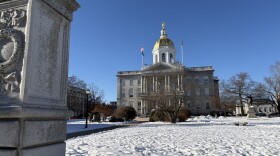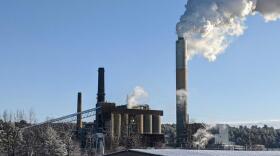Some electricity customers in New Hampshire are in for a shock this winter. Numerous utilities across New England have announced electricity rates that are some of the highest in the history of the continental United States. And it’s a problem that’s expected to get worse before it gets better.
For some consumers, this is more real than for others. Don Sage and his wife make due on a bit less than $30,000 a year in social security payments. So he can ill-afford to pay another $40 a month on his electric bills.
“When the invoice comes in the mail to get paid, I have a target amount that we can fluctuate up or down, based on our fixed budget,” says Sage.
Utility rates, and the energy market in general are pretty inscrutable to most energy customers, but in reality, these retail rate-hikes have been a long time coming.
Hard To Bottle
To understand what’s going on here, you need to know that in the last dozen years New England went from getting 15 percent of its energy from natural gas to almost half.
There are a couple of problems with that.
For one, compared to other fuel sources, it’s really hard to store natural gas. You can get a sense of this at Distrigas, New England’s only Liquefied Natural Gas Import terminal, just north of Boston.

Distrigas has two massive tanks, which when full, contain enough gas to fuel all of New England’s for about one winter day.
“These tanks themselves are a tank within a tank, they’re like big thermos bottles.” Says Tony Scaraggi, Vice President of operations at Distrigas.
Natural gas as a liquid takes up 600 times less space than as a gas, so that’s how it’s typically stored. But its chemical properties mean it has to be really cold before it becomes a liquid.
In some places, space isn’t a problem, because natural gas is stored in massive underground caverns. New England’s geology doesn’t have any of those, so we’re stuck super-cooling it, and keep it in big expensive thermoses.
Compare that to coal, which you can keep in a big pile.
“Just-In-Time” Delivery

All of the hassle and expense means most natural gas power plants don’t have storage tanks; instead they tap into the region’s pipelines.
The problem with that? On the coldest days, there just isn’t enough space in the pipelines to go around. So when the temperatures drop, demand rises and electric plants bid up the prices: we’re talking easily five times higher on certain cold days.
“In New England, this winter, based on what’s been recently trading, is likely to have the highest natural gas prices on planet earth,” Taff Tschamler, chief operating officer of energy supplier North American Power, told an energy conference this fall. That’s traders hedging against another winter as cold as last year.
According to Competitive Energy Services, a private energy consulting firm, Gas for January delivery is trading at nearly $19 per million BTUs. In Japan, which relies entirely on imported gas and often has the world's highest prices, gas is forecast to cost less than $18 this winter.
There’s no doubt that New England gas demand has outstripped pipeline supply, and the market is responding. Two small pipeline expansions, which together would increase regional capacity by about 10 percent, should come online by late 2016. And two much bigger competing projects have been proposed for 2018, which together would come close to doubling the pipeline capacity in New England.

But How Much…
Wherever you have a proposal to build energy infrastructure, you have opponents.
Marilyn Learner, a retired school-teacher, took me on a driving tour of the proposed route of a pipeline that Kinder-Morgan wants to bury under Hollis, New Hampshire.
“The pipeline is paralleling this, you see that entire bank of trees? Gone, gone, all of it, gone,” she says getting out of her car in Beaver Brook, a large conservation area in the town.
Talk of eminent domain and 100-foot-wide clear cuts have stirred emotions along the proposed route of the pipeline, which mostly cuts across Northern Massachusetts. Opposition has been has been so fierce that both of Massachusetts’ US senators and a number of congressmen have come out against it. In part thanks to grassroots opposition from people like Learner.
“Ok we need some gas, I get that,” says Learner, frustrated, “Why did the state and the region not form a plan about how to get the gas? Why does a private company run the show?”
But resistance is not just coming from the folks who don’t want a pipeline in their backyard. Power plant owners who prefer that the government stay out of the electric market are pushing back against a preliminary proposal, signed by the six New England Governors last year, calling for a subsidy for new gas pipelines.
The idea is that electric ratepayers would pay for pipelines to be built larger than they would be otherwise.
Environmental groups have joined the fray too, saying the region risks building too much pipe.

“If demand for gas remains low, because of things like energy efficiency, distributed generation, renewable heating technology like heat-pumps and biomass, we may not need any infrastructure overall,” says Peter Shattuck, of Environment Northeast.
That’s a view shared by natural gas market analyst Greg Lander. He points out there were only 42 days last year when the region’s pipelines were close to capacity. So if you build too much pipeline, most of the time you pay for it to sit empty.
“Just like if you had 10 airplanes flying every hour to New York. Nine of those airplanes would fly empty in the lowest demand periods,” Lander says.
These concerns are among the reasons that the subsidy proposal has stalled, for now.
Many Interests, Many Proposals
So what’s a region that’s been rocked by spiking gas prices to do? It depends what you’re promoting.
One or both of the big proposed pipeline expansions could get built, which is what some industrial gas users in Maine have argued will be necessary. As of early October, Kinder-Morgan said it has already signed up 60 percent of the minimum number of customers it needs to build its pipeline.
And Spectra Energy, the competitor to the contentious Kinder-Morgan project, is proposing upgrading its existing network with wider pipes. It’s offering new kinds of contracts aimed squarely at the power plant sector to help get the expansion built.
“They’re different services that would allow an electric power generator to call us with very short notice and ask to be able to run, and we would have the capability to do that,” says Greg Crisp Director of business development with Spectra.
Others say the region could get by with only a small increase in pipeline capacity, if it was smarter about using what it has.
Tony Scaraggi, the Liquefied Natural Gas importer, argues that burning more expensive imported LNG on the forty or so cold days per year is still cheaper than over-building a pipeline.
“That’s equivalent to like, 2.5 to 3 LNG tankers coming in,” he says, “So you gotta compare that to the cost of a $2 to $3 billion pipeline.”
And then of course, Peter Shattuck, with Environment Northeast, has the enviro package to pitch – increased energy efficiency, harnessing waste heat from power plants, building energy storage – and yes, renewables.
“Wind, with a mix of hydro coming down from Northern Maine and the Canadian provinces could also offset the need for a lot of natural gas in the region,” Shattuck says.
Many electricity market operators say that some help is already on the way. A market reform by New England’s grid operator (ISO-NE) coming in 2018 would fine natural gas plants that don’t have fuel when they need it, and give the proceeds to plants that do have fuel. That would give them a financial incentive to reserve space on a yet-to-be built pipeline, or buy some natural gas from overseas.
But none of this will help this year, and so for the second year in a row, the ISO is paying for an insurance plan: a program to pay power-plants to stock up on fuel, just in case.
In the shortest of terms, the region’s electricity prices will be largely dependent on the weather.
“What I think we’re hoping for is that the good lord who protects drunks and the United States, will also protect New England,” said Peter Brown, an energy attorney with the law firm Preti-Flaherty, at this fall’s energy conference.
In other words, pray for a warm winter.








